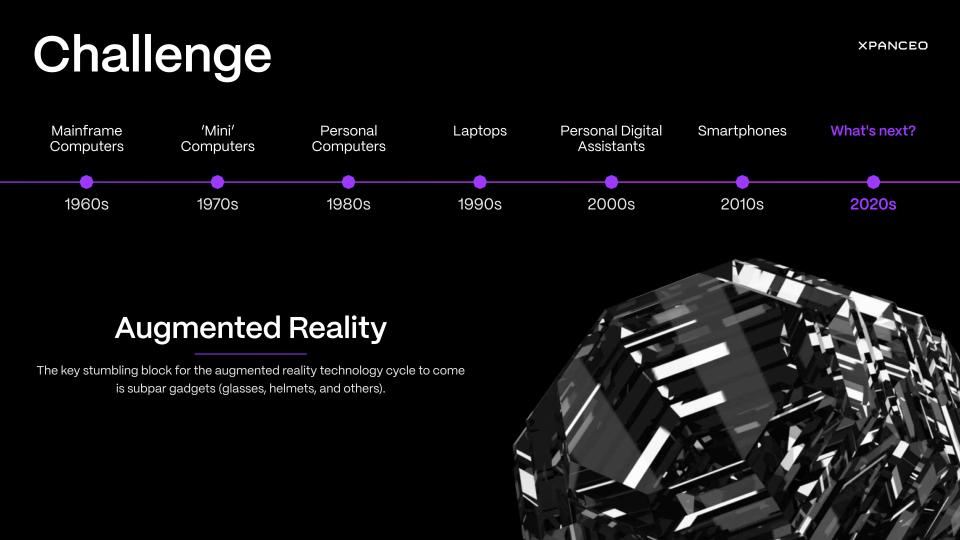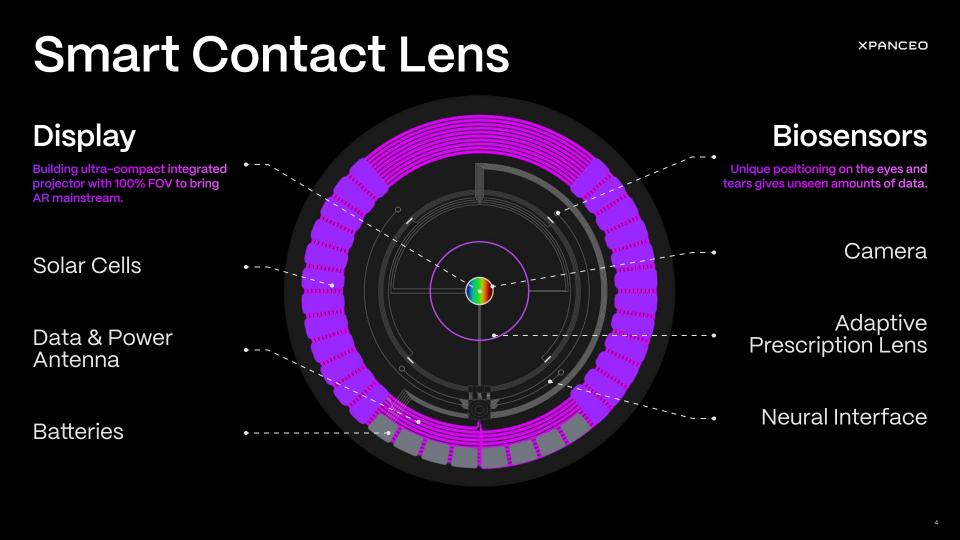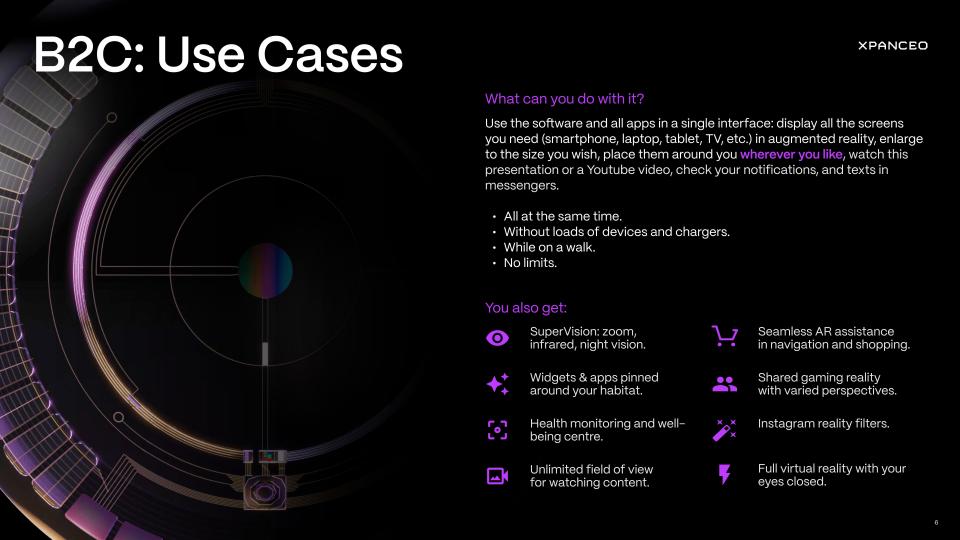Pitch Deck Teardown: Xpanceo's $40M seed deck
Xpanceo is betting big on turning us all into cyborgs with smart contact lenses, securing a cool $40 million to make our sci-fi dreams a reality. Co-founders Roman Axelrod and Valentyn S. Volkov are on a mission to ditch traditional gadgets and make everyone's eyes the new screens. Who needs smartphones when you can blink to browse? As they push the boundaries of what's possible with optoelectronics and new materials, one can't help but wonder if we're heading toward a future where losing your contacts could mean missing your next Zoom meeting.
We're looking for more unique pitch decks to tear down, so if you want to submit your own, here's how you can do that.
Slides in this deck
Xpanceo has shared its complete presentation deck, consisting of 19 slides, with TechCrunch. Although the slide list suggests that the team has covered everything, a closer look at the deck's contents reveals that some areas might not be as comprehensive as they seem.
Cover slide
Challenge
Solution
Product
Value proposition
B2C: Use cases
B2B: Industries
Traction
Contact lens users
Market size
Revenue forecast
Competition
What is Xpanceo? interstitial
Overview
Technologies
Pioneering R&D in optical analysis
Team
Roadmap
Closing slide
Three things to love about Xpanceo's pitch deck
There's a lot of really good storytelling happening here.
A slice of history

[Slide 2] A clear problem statement. Image Credits: Xpanceo
The presentation effectively begins with a clear problem statement, setting the stage for a focused discussion on the challenges and opportunities in the realm of augmented reality (AR) and wearable technology. This explanation is crucial, as it immediately frames the issues that Xpanceo is addressing with its innovative smart contact lens project. By articulating the problems upfront, the deck ensures that the audience understands the context and significance of the technology being developed, which is essential for garnering support and enthusiasm for the project. I love that.
The inclusion of a timeline detailing the evolution of computing technology within the presentation is particularly clever. This historical perspective not only educates the audience about the progression and milestones in computing but also situates Xpanceo's work within a larger narrative of technological advancement — and many of those advancements made a lot of investors very wealthy indeed.
What's the problem with AR?
Addressing the shortcomings of AR as it stands, the presentation acknowledges that the tech has not yet achieved widespread adoption primarily due to poor product offerings that have failed to resonate with consumers. This is true, and it shows that Xpanceo is aware of the hurdles faced by previous AR technologies and is committed to overcoming these challenges.

[Slide 3] Easing into the "solution" is a great approach. Image Credits: Xpanceo
There's a big difference between a "solution" and a "product" slide. Xpanceo's take here is refreshingly clear on the differences.
The solution slide is strategic in nature, emphasizing a broader, more adaptable approach rather than focusing solely on the product. This strategic mindset is crucial, as it shifts the emphasis from the specifics of the product to the underlying philosophy of problem-solving.
I love that the solution is articulated in a clear and accessible way, deliberately avoiding excessive detail. This clarity is essential for communicating effectively with stakeholders, including investors, potential customers and team members. By keeping the solution straightforward and easy to understand, the team ensures that everyone involved has a solid grasp of the core concept and objectives. This level of transparency fosters trust and alignment among all parties, which is important for collaborative efforts and the overall success of the project.
From there, you can drop into the details: the product.
So here's what the company's actually up to
Again, Xpanceo does a great job:

[Slide 4] This slide draws investors in. Image Credits: Xpanceo
The product slide does an excellent job of presenting the product in a clear and engaging manner, avoiding the common pitfall of descending into overly technical language that can alienate or confuse the audience. This approach is particularly powerful given the complex nature of the technology involved.
Smart contact lenses that integrate advanced computing capabilities directly into the user's visual field feels like magic. Still, by maintaining straightforward and accessible language, the slide ensures that the innovation can be understood and appreciated by a broad audience, which is crucial for generating interest and support among potential investors.
I particularly love how this clarity helps set the stage for deeper discussions, all without getting lost in the complex technological language that no doubt happens in the lab. It strikes the right balance between simplicity and informativeness.
Three things that Xpanceo could have improved
This deck is really good. But is it perfect?
Nope. Let's dive in.
What are you raising?

What? Image Credits: Getty Images
The biggest problem with the Xpanceo deck isn't what is in there, but rather what isn't.
One critical element missing from the deck is the "ask" slide, which is essential when seeking venture capital funding. It's surprising how often founders overlook this component in their pitch decks. When raising money, it's not the time to be reticent or indirect. Clearly stating what is being asked for — be it staffing, resources or partnerships — demonstrates to potential investors a well-thought-out plan and a serious commitment to the startup's future. This helps investors quickly understand the needs and assess whether they align with their investment criteria.
Including a specific ask in the presentation also conveys that there is a realistic understanding of what the startup requires to succeed. It shows that careful consideration has been given to how much funding is needed, what it will be used for, and how it will help the company achieve its goals. This level of detail and transparency adds credibility to the pitch and instills confidence in potential investors about the management and planning capabilities. It positions the entrepreneurs as serious individuals who are not merely experimenting but are committed to building a sustainable business.
B2B or B2C: You can't have both
Slides 6 and 7 make a case for both a B2B and a B2C model. That's not a great call.

[Slide 6] A use-case brainstorm is clever, but it's important to come up with the real use cases that drive the investment decision. Image Credits: Xpanceo
B2B and B2C business models are fundamentally different beasts. Very few companies are able to do well with one strategy, never mind both.
B2C sales are distinguished by direct interactions with individual consumers, focusing on emotional engagement, brand identity, and creating personalized customer experiences. This model thrives on short sales cycles and immediate purchase decisions, making it crucial for companies to invest in understanding consumer behaviors and crafting marketing strategies that resonate on a personal level. Even if companies occasionally purchase under a B2C model, they should be treated as consumers in the sales process to maintain simplicity and efficiency in marketing efforts.
Conversely, B2B sales involve more complex transactions with other businesses, characterized by longer sales cycles, higher transaction values, and a focus on practical benefits and cost-effectiveness. This model requires strong, credible relationships and often involves customized solutions to meet specific business needs. While it's less common, consumers may sometimes engage with products designed for business use, highlighting the flexibility required in sales strategies. Ultimately, focusing on a B2B or B2C sales organization should align with the startup's core capabilities and strategic goals, shaping the narrative in their startup pitch to attract potential investors.
Trying to do both won't work, so pick one, and explain why that's the right choice.
The market sizing fallacy

[Slide 9] Sure, there are a lot of contact lens users. But are they really a proxy for Xpanceo customers? Image Credits: Xpanceo
When assessing the potential market size for Xpanceo’s contact lenses, it's crucial to differentiate the nature of the product from traditional contact lenses. Or, put differently: Is the market for Xpanceo's product people who are already wearing contacts? The company seems to think that everyone who wears contacts wants smart contacts. But that's probably not accurate.
Xpanceo's offerings are not merely an alternative to spectacles for optical correction but rather function as a wearable device. This distinction is significant because the target market for Xpanceo may not align directly with the existing base of contact lens users. Instead of evaluating the total number of contact lens wearers, a more relevant metric might be the usage of related technology such as smartphones or smartwatches, which reflects a tech-savvy consumer base more likely to adopt new wearable technologies. This approach can help in identifying not just a broad audience, but also one that is more likely to embrace innovative products.
Xpanceo’s go-to-market strategy plays a pivotal role in determining its primary consumer segment. If the product is designed for mass market consumption, the strategy should focus on identifying and engaging an early adopter group. This group typically consists of tech enthusiasts who are keen on exploring and adopting cutting-edge technologies. These early adopters could provide the initial traction needed to penetrate the market, acting as influencers and validators for the broader consumer base. Their feedback is also invaluable when it comes to refining the product and enhancing its appeal to subsequent buyers.
I think the company is trying to show that its market is huge, but I doubt that contact lens wearers are a proxy. I wear contacts, but only when I'm doing contact sports (martial arts or scuba diving). But even if I had never worn contacts a day of my life, I'd be eager to try the Xpanceo solution.
I think the company is trying to compare oranges to Apple computers.
The full pitch deck
If you want your own pitch deck teardown featured on TechCrunch, here’s more information. Also, check out all our Pitch Deck Teardowns all collected in one handy place for you!

